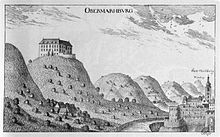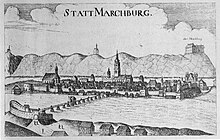Lordship of Marburg

The rule of Marburg , also rule of Obermarburg , rule of the upper castle or Upper Marburg rule was the basic rule of the country around Marburg an der Drau in today's Slovenia , and thus fulfilled the protective function of the imperial city.
Power structure and nature
The city of Marburg was between two Marburg castle lords. On the one hand that of Obermarburg , which was built on the Piramidaberg in 1164 , and gave the city its name, and on the other hand that of Untermarburg , which was administered from the Marburg Stadtburg .
The rule of Marburg comprised the following offices and mining rights in the 15th and 16th centuries :
- The offices of Pachern , Hartl, Wildhaus / Viltuš , Rosbach / Rošpoh , Leitersberg bri Mariboru , Zirknitz / Cirknica , Troboschetz, Sankt Jakob, Platsch / Plač , Neudorf ob Wildon , Wurmberg / Vurberk , Brunndorf , Neudorf ob holy cross, Qualetnitz, Pollon ob Holy Cross, Schalauzen, Oberer an der Libau, Ober-Rohr, Lannersorf, Kranau, Fridau / Ormož , Oberbrobrang
- The mountain rights on Bachern (Pacherberg, Pohorje) , Amasberg, Hunntzberg, on Stepferberg, in the Hell, zu Leuttersberg, on Sturmbergerberg, Freideggerberg, Gotschinberg, Gotschaberg, Marburger Schloßberg, Rabanerberg, Reschützenberg, Trankoviz, Reschitzberg, on the Gugl am Rosbacherberg, in Margraben, Rosbacherberg, Seebacherberg, Wurmberg, Preisberg. Further mining rights to Ober-Rohr, Pibanerberg, Kranau, Ober-Probranikberg, Pänerdorfer Berg, Kazianer Berg, Wildhauserberg, to Gräscha and in Potutsch.
In 1527, 267 subject families , 109 of them with residents , were registered. In 1542, 283 submissive families lived in 23 villages on the rule of the upper Marburg Castle. From the estates (validity) of the Lords of Graben from the same year, Obermarburg Castle and adjacent grounds were estimated at approximately 3870 pounds , the other offices and mining rights belonging to the lordship were estimated at 50,045 pounds.
Economy of rule in the early modern period
At the time of the late Middle Ages and the early modern period , viticulture was an important branch of trade for the Upper Marburg rule. Although the lordship acquired some new vineyards , it only had approximately 600 authorized vineyards in 1542, which was much less than at the beginning of the 16th century. About 30 of the privileged Bergholden belonged to various noble families, but most of them were owned by Marburg citizens.
From the records of the property appraisal of the subjects it can be seen that in the middle of the 16th century, tradespeople also practiced their craft in the dominion's villages. The subjects were mostly locals as well as a minority of German names. However, their prosperity was endangered by the economic crisis that prevailed in the 15th and 16th centuries and the Turkish invasions .
Ruler
| Period of time | family | Individuals |
|---|---|---|
| ???? - 1456 | Lords of Walsee | Wolfgang von Walsee (until 1456) |
| 1456-1564 | Lords of Trench | Friedrich II. Von Graben (until 1463), Ulrich III. von Graben (until 1486), Wolfgang von Graben (until 1521), Wilhelm von Graben (until 1523), Georg Siegmund von Graben (until after 1544), Andrä von Graben (until 1556), Anna von Graben (until 1564) |
| 1564-1620 | Lords of Stadl | Carl von Stadl (until 1576), Erasmus Stadler, Franz Stadler |
| 1620-1727 | Count Zwickel called Khiesl | Georg Bartholomeus Zwickel called Khissl (until 1656), Jakob Bartholomä Zwickel called Khiesl (until 1691), Anna-Maria Zwickel called Khiesl (until 1703) |
| 1727-1918 | Counts of Brandis | Jakob von Brandis (1727 to 1746). |
literature
- Saso Radovanovic: The city of Marburg in the first half of the 16th century. In: Scientific work from Burgenland . Issue 88, 1992, p. 336, PDF on ZOBODAT
Individual evidence
- ↑ Radovanovic 1992, p. 336.
- ↑ Adalbert Sikora: The Lords of the Trench. In: Journal of the historical association for Styria. 51. Jg., 1960, ISSN 0437-5890 , pp. 42-94, here pp. 78-79
- ↑ Adalbert Sikora: The Lords of the Trench. In: Journal of the historical association for Styria. No. 51, 1960, ISSN 0437-5890 , pp. 42-94, here p. 79
